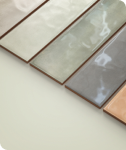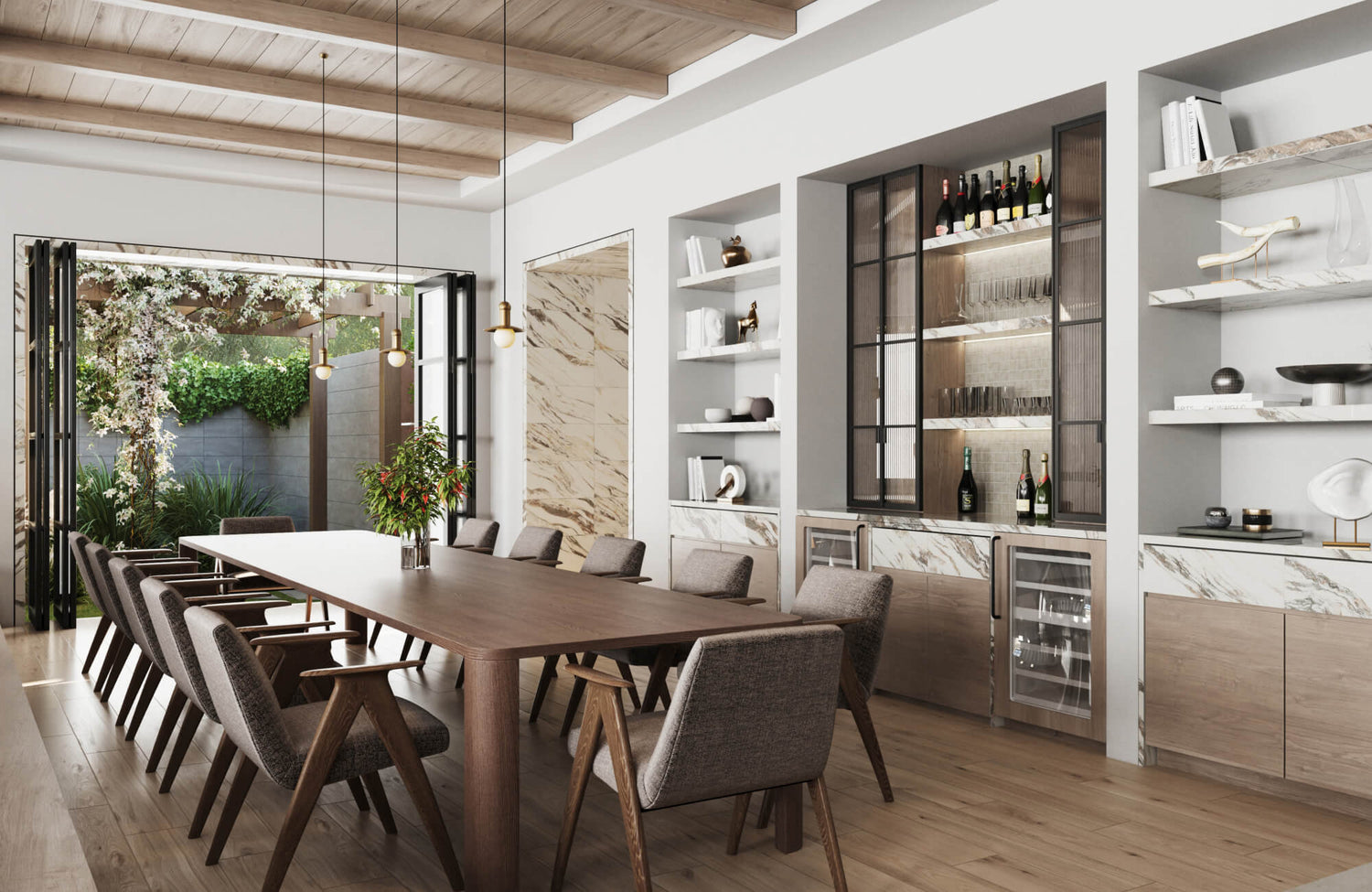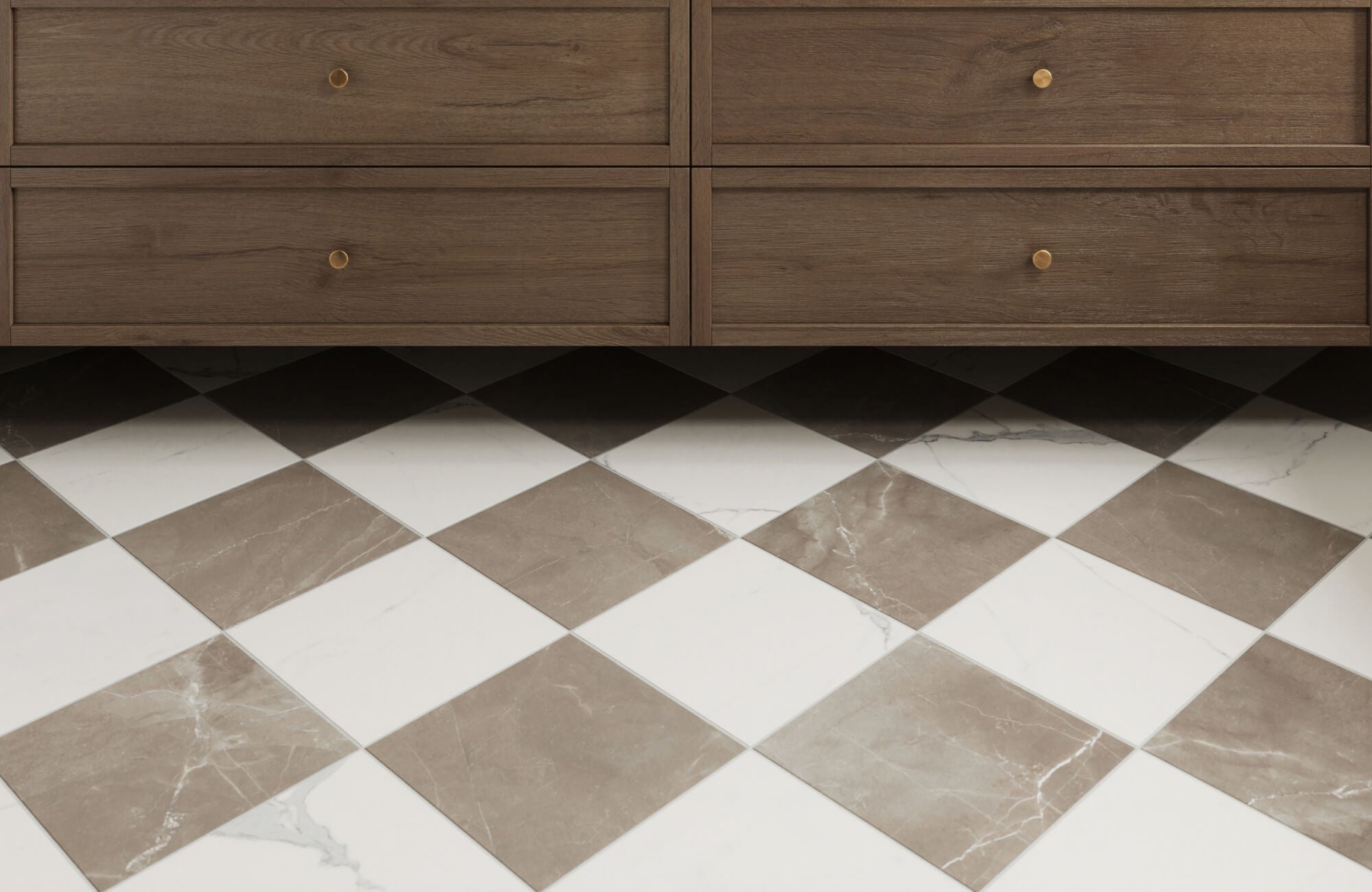Wood look tile has quickly gained popularity as a flooring option that combines the classic charm of hardwood with the durability and practicality of porcelain or ceramic tile. Its realistic design and long-lasting performance have made it a favorite among homeowners and interior designers, especially for those looking to bring warmth and texture into their spaces without the upkeep that natural wood demands.
In this article, we’ll take a closer look at what makes wood look tile such a compelling choice. From its impressive durability and visual appeal to its affordability, easy maintenance, and eco-friendly benefits, we’ll explore all the key factors that contribute to its growing appeal. Whether you're planning a renovation or simply weighing your options, this guide will help you understand why wood look tile continues to be a top pick for modern interiors.

The Innovation Behind Wood Look Tiles
Wood look tiles, such as our Jameson 8x48 Grip Porcelain Tile in Camel seen above, have become a standout in modern flooring, combining cutting-edge technology with thoughtful design. They capture the classic beauty of hardwood while avoiding many of its natural limitations. As a result, these tiles have reshaped how homeowners and designers approach flooring in both residential and commercial spaces. But what exactly gives them their impressive realism and practical advantages?
Composition
Wood look tile is a smart solution that successfully captures the warmth and character of hardwood while delivering enhanced functionality. Crafted from either ceramic or porcelain, these tiles are carefully designed to replicate the appearance, texture, and feel of real wood. This level of detail is made possible through advanced printing techniques that apply authentic wood grain patterns directly to the tile surface.
Beyond visuals, these tiles also offer impressive dimensional stability, helping them resist the warping and bending that natural wood can experience due to humidity or temperature changes. Many styles are also finished with textured surfaces that closely mimic the touch of real wood, creating an experience that feels as authentic as it looks.
Manufacturing Process
The process of creating wood look tiles begins with a blend of clay and color pigments, which are shaped and fired in high-temperature kilns to produce strong, water-resistant tiles. These tiles are typically available in two main types: porcelain and ceramic. Porcelain is valued for its density and hardness, making it well-suited for busy areas, while ceramic offers a solid balance of durability and affordability.
Recent advancements in manufacturing have taken wood look tiles to the next level. High-resolution digital printing and specialized glazing techniques now allow manufacturers to replicate the fine details of natural wood grain, including the unique variations found in exotic hardwoods. These innovations also include protective wear layers that guard against fading and surface damage, contributing to long-term performance. Because of a controlled production process, the tiles maintain consistent color and texture, making installation easier and helping achieve a natural, cohesive finish.
Practical Advantages
When compared to traditional hardwood, wood look tile offers several practical benefits that make it a smart flooring choice. Its durable surface resists scratches, dents, and stains, allowing it to maintain a clean and polished appearance even in heavily used areas. This makes it ideal for households with pets, children, or heavy furniture.
In addition to its toughness, wood look porcelain tile is naturally water-resistant. This makes it especially suitable for moisture-prone areas such as bathrooms, kitchens, and basements. Another key benefit is its hypoallergenic nature; unlike hardwood, it doesn’t trap allergens like dust or pet dander, creating a cleaner environment for those with allergies or respiratory sensitivities.
Comparing Lifespans: Hardwood vs. Wood Look Tile
The lifespan of flooring is a key consideration for many homeowners, and both hardwood and wood look tile can offer impressive longevity, though each comes with its own set of conditions. Traditional hardwood flooring can last anywhere from 25 to 100 years, depending on the species and level of care. However, its natural surface is prone to scratches, dents, and water damage. Everyday wear from frequent use, furniture, pet claws, and even changes in humidity can gradually impact its appearance and structure.
To maintain hardwood’s visual appeal and structural integrity, regular upkeep is essential. This often includes periodic refinishing, careful cleaning, and protection from moisture. While refinishing can extend the life of the floor, it also adds to the long-term cost and effort of maintaining hardwood. Without proper care, even high-quality hardwood can begin to show signs of wear within a few years.
Wood look tile, by comparison, is built for long-term durability with far fewer maintenance requirements. Its dense ceramic or porcelain construction resists scratches, dents, and moisture, allowing it to retain its appearance and structure over time. On average, wood look tile can last 50 years or more when properly installed and maintained. Unlike hardwood, it does not need refinishing or sealing. Individual tiles can be replaced if necessary, but the floor as a whole remains stable and consistent, even in busy areas. For homeowners looking for a reliable, long-lasting flooring option with minimal upkeep, wood look tile proves to be a smart and practical choice.
Versatility Across Design Styles
One of the most appealing qualities of wood look tile is its ability to adapt to a wide range of interior styles. For rustic or farmhouse-inspired spaces, weathered or reclaimed wood designs bring warmth and character. In more contemporary homes, cleaner wood patterns with sleek finishes offer a minimalist, refined look. Even traditional interiors can benefit from wood look tile, especially when it complements classic features like crown molding or detailed trim. Because of this versatility, these tiles work particularly well in transitional spaces, helping bridge the gap between traditional charm and modern simplicity.
In addition to style flexibility, wood look tile is available in a broad spectrum of color tones, making it easy to coordinate with any interior palette. Whether you're aiming for soft neutrals, cool greys or deep brown, such as our Preston 8x48 Matte Porcelain Tile in Teak, there is a shade to suit your space. These tiles can also be arranged in a variety of patterns such as herringbone, chevron, or staggered layouts to introduce visual texture and movement.
For those looking to take their design a step further, Edward Martin offers a professional design service to help select and lay out the ideal wood look tile. From the first consultation to the final installation, this service ensures that your flooring not only complements your style but also functions well for your daily needs.

Cost-Effective Flooring
Choosing flooring today involves more than just finding a style that looks good; it also means making a smart investment. Wood look tile stands out as an option that delivers both visual appeal and long-term value. By offering the charm of hardwood at a more accessible price point, it gives homeowners the opportunity to achieve a high-end look without stretching the budget.
Initial Costs and Installation Considerations
When weighing flooring options, cost plays a major role, and wood look tile, such as our Preston 8x48 Matte Porcelain Tile in Birch above, often presents a strong value compared to traditional hardwood. The total expense usually includes the tile itself, labor for installation, and any additional materials needed for the project. In general, wood look tile tends to be more affordable per square foot than hardwood, especially when compared to premium wood species.
However, it’s worth noting that installation may come with a slightly higher labor cost, as it often requires specialized skills. Still, the initial investment in wood look tile is typically lower overall, particularly for larger spaces or full-home installations. With a wide variety of sizes and designs available, the complexity of the layout can also influence installation time and cost, but this flexibility gives homeowners the chance to tailor both style and budget.
Long-Term Savings and Durability
Over time, the cost savings of wood look tile become even more apparent. Its durability greatly reduces the need for repairs or replacements caused by scratches, dents, or moisture damage, issues that hardwood floors are more susceptible to. The minimal maintenance it requires also means fewer expenses for cleaning products or professional refinishing services.
High-quality wood look tile can add value to your home. Buyers often appreciate its durability, low upkeep, and polished appearance. These qualities make it an attractive feature during resale. Since wood look tile resists fading and holds up well in busy areas without needing restaining or sealing, it offers consistent visual appeal and reliable performance for years to come.

Effortless Upkeep with Simple Care Tips
One of the standout benefits of wood look tile is how easy it is to maintain. While it offers the look and feel of real wood, it eliminates the time-consuming upkeep that often comes with natural materials. For homeowners looking for a low-fuss option that still looks polished and refined, this type of flooring delivers a practical and reliable solution. From everyday cleaning to managing occasional spills or small fixes, keeping wood look tile in great shape takes very little effort.
Daily Cleaning Made Easy
Caring for wood look tile is simple. Regular sweeping or vacuuming helps remove dust and dirt, and a quick mop with a mild detergent is usually all it takes to handle spills or surface grime. Because the tile surface is non-porous, it resists moisture and prevents stains from setting in, making cleanup straightforward and efficient. The tile’s durable surface also helps protect against everyday marks and wear, preserving its clean and polished look over time.
Simple Repairs and Long-Term Care
Maintaining wood look tile over the long term is just as easy. If a tile becomes chipped or cracked, individual pieces can be replaced without disrupting the rest of the floor. This makes small repairs quick and budget-friendly. With basic care and the occasional fix when needed, wood look tile can continue looking its best for many years. Unlike some flooring materials, it doesn't require sanding, sealing, or specialized treatments to preserve its finish.
Eco-Friendly Flooring
As sustainability becomes a growing priority for many homeowners, wood look tile presents an appealing eco-conscious flooring option. It combines style with environmental responsibility, offering the charm of hardwood without the environmental impact that comes with harvesting natural wood. Unlike traditional hardwood, which often contributes to deforestation and intensive resource use, wood look tile is made using more sustainable materials and production methods. It’s a smart choice for those who want to reduce their environmental footprint while still achieving a beautiful, long-lasting finish.
Sustainable Production Methods
One of the key environmental benefits of wood look tile lies in how it’s made. The manufacturing process typically relies on abundant, naturally occurring materials like clay and sand, which are widely available and renewable. This stands in contrast to hardwood flooring, which requires tree harvesting and contributes to habitat loss and long-term environmental degradation.
In addition, producing wood look tile generally consumes less energy than the processing and finishing involved with hardwood. The streamlined manufacturing process helps limit waste and reduces greenhouse gas emissions, supporting more sustainable practices in the building materials industry. For eco-aware homeowners, this makes wood look tile a responsible and thoughtful flooring choice that aligns with modern values around sustainability.
Recycling and Reduced Carbon Footprint
Many tile manufacturers are taking important steps toward sustainability by incorporating recycled materials into their production processes. This reduces the need for virgin resources and helps lower the overall environmental impact of flooring materials. Some wood look tiles are even made using recycled glass and other eco-friendly substances, which further contributes to a smaller carbon footprint.
These efforts not only help conserve natural resources but also support broader sustainability goals within the flooring industry. By using post-consumer and post-industrial waste, manufacturers are able to divert significant amounts of material from landfills. In addition, more facilities are turning to renewable energy sources to power their operations, adding another layer of environmental benefit to the production of wood look tile.
Energy Efficiency and Indoor Air Quality
Wood look tile also plays a role in improving energy efficiency at home. Thanks to its strong thermal conductivity, it can help regulate indoor temperatures by retaining and distributing heat more effectively. This can reduce the strain on heating and cooling systems, leading to more consistent comfort and lower energy use over time.
Beyond energy performance, wood look tile also supports healthier indoor air quality. Unlike some flooring materials, it does not emit volatile organic compounds (VOCs), making it a safer option for families and individuals with sensitivities. Its ceramic or porcelain composition is also naturally resistant to mold and allergens, creating a cleaner, more comfortable living environment.
Recyclability at End of Life
When wood look tile reaches the end of its lifespan, it continues to offer environmental benefits through its recyclability. The materials used in its production can be crushed and reused in new applications, including construction fill, road base, or landscaping materials. This ability to return to the production cycle helps support a closed-loop system that reduces waste and conserves valuable resources.
Recycling wood look tile not only enhances its environmental profile but also provides a practical solution for homeowners who want to make thoughtful, sustainable choices. In many cases, the energy required to recycle these materials is lower than the energy needed to produce new tiles from scratch. This makes wood look tile a forward-thinking option that aligns with long-term sustainability goals, even after its use in the home has come to an end.
Why Wood Look Tiles Are a Smart Choice
Wood look tile has become a compelling flooring choice by blending visual appeal with everyday practicality. Its durability, minimal upkeep, and design flexibility make it a strong fit for a wide range of interiors. By considering key factors like cost, installation, and environmental impact, homeowners can feel confident in choosing a surface that not only looks great but also stands the test of time. What sets wood look tile apart is its ability to deliver the warmth and elegance of hardwood without the common drawbacks, offering a stylish yet sensible solution for modern living.
To help you see how it might look in your own space, Edward Martin offers an advanced AR tool. This interactive feature lets you visualize tile layouts in real time, giving you a clearer idea of how each option fits with your style and layout. It’s a simple, convenient way to make an informed flooring decision, right from home.








